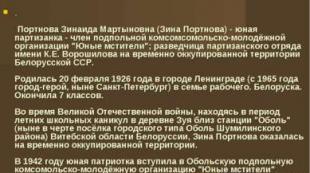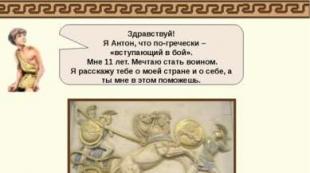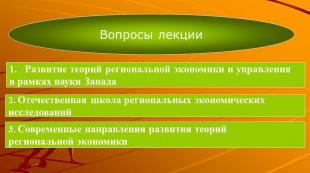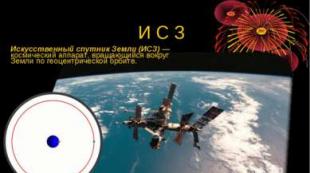Download presentation on artificial earth satellites. Presentation "first satellite" presentation for the lesson on the topic. for applied tasks
The scientists M. V. Keldysh, M. K. Tikhonravov, N. S. Lidorenko, V. I. Lapko, B. S. Chekunov, A. V. Bukhtiyarov and many others.
The satellite looked like a ball with a diameter of 58 centimeters, equipped with four antennas more than two meters long (in fact, there are two antennas, each consisting of two parts). Its mass was 83 kilograms, of the equipment on it there were only two radio transmitters with power sources that worked for two weeks after launch. The satellite transmitted the famous "beep-beep" at a frequency of 20 MHz.
The spherical shape of the body contributed to the most accurate determination of the density of the atmosphere at very high altitudes, where scientific measurements have not yet been made. The body was made of aluminum alloy, and the surface was specially polished to better reflect sunlight and provide the necessary thermal conditions for the satellite.
Receiving signals from radio transmitters allowed scientists to study the conditions for the passage of radio waves from space to Earth. In addition, they also transmitted information about the pressure and temperature inside the satellite. The satellite was unoriented, and the four-antenna system of antennas gave almost uniform radiation in all directions, in order to exclude the influence of its rotation on the intensity of the received radio signals.
The power supply of the onboard equipment of the satellite was provided by electrochemical current sources (silver-zinc batteries) designed to operate for at least 2 - 3 weeks. Inside the satellite was filled with nitrogen. The temperature inside was maintained within the range of 20-30°C with the help of forced ventilation based on signals from temperature sensors.
The Russian word "sputnik" immediately entered the languages of all peoples of the world. Full houses on the front pages of foreign newspapers of those days in 1957 were full of admiration for the feat of our country. "The greatest sensation of the century", "Humanity's cherished dream come true", "The Soviets have opened a window to the Universe", "This great victory is a turning point in the history of civilization", "It is already clear that October 4, 1957 will forever go down in the annals of history "- these are some of the then headlines of the world press.
The work can be used for lessons and reports on the subject "Astronomy"
Ready-made presentations on astronomy will help to visually show the processes taking place in the galaxy and space. Astronomy presentation can be downloaded by both teachers, teachers and students. The astronomy school presentations in our collection cover all the astronomy topics that children learn in public school.
slide 1
slide 2
 An artificial Earth satellite (AES) is a spacecraft revolving around the Earth in a geocentric orbit. I S Z
An artificial Earth satellite (AES) is a spacecraft revolving around the Earth in a geocentric orbit. I S Z
slide 3
 Types of satellites Astronomical satellites are satellites designed to study planets, galaxies and other space objects. Biosatellites are satellites designed to conduct scientific experiments on living organisms in space. Remote sensing of the Earth Spacecraft - manned spacecraft Space stations - long-term spacecraft Meteorological satellites are satellites designed to transmit data in order to predict the weather, as well as to observe the Earth's climate. Navigation satellites Reconnaissance satellites Communications satellites Telecommunications satellites Experimental satellites
Types of satellites Astronomical satellites are satellites designed to study planets, galaxies and other space objects. Biosatellites are satellites designed to conduct scientific experiments on living organisms in space. Remote sensing of the Earth Spacecraft - manned spacecraft Space stations - long-term spacecraft Meteorological satellites are satellites designed to transmit data in order to predict the weather, as well as to observe the Earth's climate. Navigation satellites Reconnaissance satellites Communications satellites Telecommunications satellites Experimental satellites
slide 4

slide 5
 Korolev: a monument to the first satellite of the Earth The first artificial satellite of the Earth was launched on October 4, 1957, and this monument was erected in honor of the 50th anniversary of this event on Cosmonauts Avenue in the city of Korolyov.
Korolev: a monument to the first satellite of the Earth The first artificial satellite of the Earth was launched on October 4, 1957, and this monument was erected in honor of the 50th anniversary of this event on Cosmonauts Avenue in the city of Korolyov.
slide 6
 The First AES The launch of the first AES, which became the first artificial celestial body created by man, was carried out in the USSR on October 4, 1957, and was the result of achievements in the field of rocket technology, electronics, automatic control, computer technology, celestial mechanics, and other branches of science and technology. With the help of this satellite, the density of the upper atmosphere was measured for the first time (by changes in its orbit), the features of the propagation of radio signals in the ionosphere were studied, theoretical calculations and the main technical solutions associated with launching a satellite into orbit were verified.
The First AES The launch of the first AES, which became the first artificial celestial body created by man, was carried out in the USSR on October 4, 1957, and was the result of achievements in the field of rocket technology, electronics, automatic control, computer technology, celestial mechanics, and other branches of science and technology. With the help of this satellite, the density of the upper atmosphere was measured for the first time (by changes in its orbit), the features of the propagation of radio signals in the ionosphere were studied, theoretical calculations and the main technical solutions associated with launching a satellite into orbit were verified.
Slide 7

Slide 8
 Manned satellite ships. Manned satellites and manned orbital stations are the most complex and advanced satellites. They, as a rule, are designed to solve a wide range of tasks, primarily for conducting complex scientific research, testing space technology, studying the natural resources of the Earth, etc. The first launch of a manned satellite was carried out on April 12, 1961: on a Soviet satellite Vostok, pilot-cosmonaut Yu. A. Gagarin flew around the Earth in an orbit with an apogee height of 327 km. February 20, 1962 went into orbit the first American spacecraft with astronaut J. Glenn on board. A new step in the exploration of outer space with the help of manned satellites was the flight of the Soviet Salyut orbital station, on which in June 1971 the crew consisting of G. T. Dobrovolsky, V. N. Volkov and V. I. Patsaev completed a wide program of scientific and technical , biomedical and other research.
Manned satellite ships. Manned satellites and manned orbital stations are the most complex and advanced satellites. They, as a rule, are designed to solve a wide range of tasks, primarily for conducting complex scientific research, testing space technology, studying the natural resources of the Earth, etc. The first launch of a manned satellite was carried out on April 12, 1961: on a Soviet satellite Vostok, pilot-cosmonaut Yu. A. Gagarin flew around the Earth in an orbit with an apogee height of 327 km. February 20, 1962 went into orbit the first American spacecraft with astronaut J. Glenn on board. A new step in the exploration of outer space with the help of manned satellites was the flight of the Soviet Salyut orbital station, on which in June 1971 the crew consisting of G. T. Dobrovolsky, V. N. Volkov and V. I. Patsaev completed a wide program of scientific and technical , biomedical and other research.
Slide 9

slide 10
 ISZ movement. AES are launched into orbits with the help of automatic guided multi-stage launch vehicles, which move from launch to a certain calculated point in space thanks to the thrust developed by jet engines. The rocket starts moving vertically upwards and passes through the densest layers of the earth's atmosphere at a relatively low speed. When lifting, the rocket gradually turns around, and the direction of its movement becomes close to horizontal. After the rocket reaches the estimated speed at the end of the active section, the operation of jet engines stops; this is the so-called point of launching the satellite into orbit. The launched spacecraft, which carries the last stage of the rocket, automatically separates from it and begins its movement in some orbit relative to the Earth, becoming an artificial celestial body. Its movement is subject to passive forces and active forces, if special jet engines are installed on board the spacecraft.
ISZ movement. AES are launched into orbits with the help of automatic guided multi-stage launch vehicles, which move from launch to a certain calculated point in space thanks to the thrust developed by jet engines. The rocket starts moving vertically upwards and passes through the densest layers of the earth's atmosphere at a relatively low speed. When lifting, the rocket gradually turns around, and the direction of its movement becomes close to horizontal. After the rocket reaches the estimated speed at the end of the active section, the operation of jet engines stops; this is the so-called point of launching the satellite into orbit. The launched spacecraft, which carries the last stage of the rocket, automatically separates from it and begins its movement in some orbit relative to the Earth, becoming an artificial celestial body. Its movement is subject to passive forces and active forces, if special jet engines are installed on board the spacecraft.
1 slide

2 slide
The launch of the first artificial Earth satellite On October 4, 1957, the whole world was shocked by the news that the first Soviet artificial Earth satellite, Sputnik-1, had been launched into near-Earth orbit. So the first step into the sky was taken. “It was small, this very first artificial satellite of our old planet, but its ringing call signs spread across all continents and among all peoples as the embodiment of the bold dream of mankind,” said S.P. Korolev, chief designer of rocket and space systems.

3 slide

4 slide
Man has dreamed of flying for a long time. And not only dreamed, but also built his own hypotheses about this. So, for example, back in 1687, the great mathematician and physicist Newton suggested that if a lead cannonball is fired from a cannon standing on a mountain, then it will fly several miles along a curve before falling to the ground. If you shoot it with double force, then it will fly off even further. By increasing the speed, you can increase the flight range, or you can make it surround the whole earth and even go into the heavenly spaces. The first to translate dreams into reality was K. E. Tsiolkovsky, when he deduced a formula for determining the speed of a rocket in outer space. Thus, already at the beginning of the XX century. there was a theoretical possibility of manufacturing artificial earth satellites. The impetus for their creation was the successful development of the first ballistic missile. The problems of its design and testing were dealt with by a group of scientists led by Academician M.V. Keldysh. For the first time, the decision to create an unoriented satellite of the Earth, launched with the help of an intercontinental ballistic missile, was made in 1956. According to preliminary calculations, it should have weighed approximately 1000-1400 kg, of which 200-300 kg was assigned to scientific equipment. The first launch was scheduled for 1957. At that time, the United States was preparing to launch its own artificial satellite. But the first attempt was unsuccessful, and the US Navy's Vanguard rocket overturned on the launch pad and exploded.

5 slide
The scientists decided to make the Soviet satellite in the form of a ball, which would allow the fullest use of its internal volume. In finished form, "Sputnik-1" (it received such a name) weighed only 83.6 kg; its diameter was 58 cm. To better reflect sunlight and provide the necessary thermal conditions, the case was made of aluminum alloy. The apparatus was powered by silver-zinc batteries capable of operating for 2-3 weeks. Four rod-shaped antennas 2.9 m long were installed on the outer surface of the apparatus, occupying a working position after entering orbit. Such a four-antenna system reduced the influence of the rotation of Sputnik-1 on the quality of signals received on Earth. In the interior of the sphere filled with nitrogen, a constant temperature was maintained by means of ventilation controlled by signals from special temperature sensors. Two radio transmitters were placed inside the apparatus, transmitting information about the pressure and temperature inside the satellite. With the help of the obtained data, scientists studied the conditions for the passage of radio waves from space to Earth. The signals were transmitted in the same way as by telegraph, with a wave length of 0.3 seconds. The transmitters worked alternately, changing after continuous operation for 14 seconds. The first satellite was called the simplest, although it had no analogues in the technology of that time. With its help it was possible to carry out a number of scientific researches. For example, thanks to the spherical shape of the body of Sputnik-1, it was possible to determine the density of the atmosphere at high altitudes with the greatest accuracy.

6 slide
October 4, 1957 at 22:28 Moscow time, Sputnik-1 was launched into orbit. He began to give the first signals from space immediately after separation from the last stage of the rocket. The first spacecraft made 1440 revolutions around the Earth, spending 96 minutes for each revolution. 10.2 sec. Its maximum distance from the Earth's surface was 947 km. It was in Earth orbit for only 92 days, after which it burned up in the dense layers of the atmosphere. But this day was the beginning of a new, space age of mankind, and the Russian word "satellite" entered many languages of the world.
Research work
WORK COMPLETED: student 4 "B" CLASS
MBOU secondary school No. 8 with. Levokumka
Kutovoy Nikolai
HEAD: teacher primary school
Samarina E. Ya.
artificial
Earth satellite"

The purpose of this work is:
- Acquaintance with the history of creation
- the first artificial Earth satellite (AES);
The value of the launch of satellites for science and all mankind.

Having overcome the earth's gravity, the Rocket broke away from the Earth ... And there was no happier moment - Here a new era began.
Step... the second... The third separated, Burning in the atmosphere without a trace... And suddenly a rapidly flying star appeared above the Earth.
And Mankind froze in amazement: A silver ball flying in the sky - A great creation of human hands - Was sent from the Earth to the Universe as a gift!

Sputnik-1 - the first artificial earth satellite ,
The code designation of the satellite is PS-1 (The Simplest Sputnik-1). The launch was carried out from the 5th research site of the USSR Ministry of Defense " Tyura-Tam "(which subsequently received the open name spaceport Baikonur ) on the launch vehicle "Satellite" ( R-7 ).

This year all progressive mankind
celebrates 60 years of launch
The first artificial earth satellite.
This was the first step towards space exploration.

The history of the creation of the first satellite is connected
with work on the rocket as such.
Moreover, she is in the Soviet Union,
and in the USA it had a German origin.
The main achievements of German specialists
mass production technology has become
powerful liquid rocket engines
and flight control systems.

Sergei Pavlovich Korolev
12.01.1907- 14.01.1966
Korolev Sergey Pavlovich - chief designer of the first launch vehicles, artificial Earth satellites, manned spacecraft, founder of practical astronautics, academician of the USSR Academy of Sciences (1958), Hero of Socialist Labor (1956, 1961), laureate of the Lenin Prize (1957), member of the CPSU since 1953 .

Single-stage missiles could not satisfy the military - they needed a multi-stage intercontinental missile capable of delivering a "cargo" to anywhere in the world. The development of such a rocket was carried out at the Design Bureau Korolev


Tikhonravov's group developed the concept of an artificial Earth satellite from 1950 to 1954 almost "underground".
In the foreground (left to right): Vladimir Galkovsky, Gleb Maksimov, Lidia Soldatofva, Mikhail Tikhonravov and Igor Yatsunsky; in the background (standing): Grigory Moskalenko, Oleg Gurko and Igor Bazhinov. (Photo courtesy of Asif Siddiqi)





"It was small, this very first artificial satellite of our old planet, but its sonorous call signs spread across all continents and among all peoples as the embodiment of the boldest dream of mankind."
C. Korolev



On February 1, 1958, the first American satellite "Explorer-1" was launched into orbit, and a little later, independent launches of satellites were made by other countries: November 26, 1965 - France (satellite "A-1"), November 29, 1967 - Australia ("VRESAT- 1"), February 11, 1970 - Japan ("Osumi"), April 24, 1970 - China ("China-1"), October 28, 1971 - Great Britain ("Prospero").





It can be concluded that science needs astronautics - it is a grandiose and powerful tool for studying the Universe, the Earth, and man himself.
Astronautics is vital for all mankind!
Every year, satellite systems will become an increasingly significant part of the Unified Communications System.

The editorial of the newspaper "Pravda", dedicated to the launch of the satellite.
Postage stamps of the USSR depicting Sputnik-1

List of sources used
1. V.P. Glushko "Cosmonautics". Publishing house "Soviet Encyclopedia" 1970
2. Rocket and Space Corporation Energia named after S.P. Korolev”, Publishing House of RSC Energia, 1996
3. Talyzin N.V. "Communication Satellites - Earth and the Universe".
4. images.yandex.ru
5.microchooser.com
slide 2
The first artificial earth satellite
slide 3
Having overcome the earth's gravity, the Rocket broke away from the Earth ... And there was no happier moment - Here a new era began. Step... the second... The third separated, Burning in the atmosphere without a trace... And a rapidly flying star suddenly appeared above the Earth. And Mankind froze in amazement: A silver ball flying in the sky - A great creation of human hands - Was sent from the Earth to the Universe as a gift!
slide 4
slide 5
This year, all progressive mankind is celebrating the 55th anniversary of the launch of the First Artificial Earth Satellite. This was the first step towards space exploration.
slide 6
The purpose of this work is: - Familiarization with the history of the creation of the First artificial Earth satellite (AES); - The significance of the launch of satellites for science and all mankind.
Slide 7
The history of the creation of the first satellite is connected with the work on the rocket as such. Moreover, it had a German origin both in the Soviet Union and in the USA. The main achievements of German specialists was the technology of mass production of powerful liquid rocket engines and flight control systems.
Slide 8
Single-stage missiles could not satisfy the military - they needed a multi-stage intercontinental missile capable of delivering "cargo" to anywhere in the world. The development of such a missile was carried out at the Design Bureau Korolev
Slide 9
Sergey Pavlovich Korolev 01/12/1907-01/14/1966 Korolev Sergey Pavlovich - chief designer of the first launch vehicles, artificial Earth satellites, manned spacecraft, founder of practical astronautics, academician of the USSR Academy of Sciences (1958), Hero of Socialist Labor (1956, 1961), laureate Lenin Prize (1957), member of the CPSU since 1953.
Slide 10
Back in 1939, one of the founders of practical cosmonautics in our country, the closest associate of Sergei Pavlovich Korolev, Mikhail Klavdievich Tikhonravov, wrote: “Without exception, all work in the field of rocket technology eventually leads to space flight.”
slide 11
Tikhonravov's group developed the concept of an artificial Earth satellite from 1950 to 1954 almost "underground". In the foreground (left to right): Vladimir Galkovsky, Gleb Maksimov, Lidia Soldatofva, Mikhail Tikhonravov and Igor Yatsunsky; in the background (standing): Grigory Moskalenko, Oleg Gurko and Igor Bazhinov. (Photo courtesy of AzifSiddiki)
slide 12
Although the satellite was called the simplest, it was created for the first time, there were no analogues in technology. Only one thing was set - a weight limit (no more than 100 kg). Quite quickly, the designers came to the conclusion that it is advantageous to make it in the form of a ball. The spherical shape made it possible, with a smaller surface of the shell, to use the internal volume to the fullest extent.
slide 13
Inside the satellite, they decided to place two radio transmitters with an emission frequency of 20.005 and 40.002 MHz. Reception of their signals would allow scientists to study the conditions for the passage of radio waves from space to Earth. In addition, it was necessary to transmit information about the pressure and temperature inside the satellite.
Slide 14
At dawn on October 3, 1957, the rocket, docked with the satellite, was carefully removed from the assembly and test building. Creators of the world's first space complex walked nearby. And the bulk of the rocket before launch was amazingly beautiful. She was all sparkling, covered with frost.
slide 15
On October 4, 1957, at 22:28 Moscow time, the brightest burst of light illuminated the night steppe, and the rocket went up with a roar. Her torch gradually weakened and soon became indistinguishable against the background of heavenly bodies.
slide 16
"It was small, this very first artificial satellite of our old planet, but its sonorous call signs spread across all continents and among all peoples as the embodiment of the boldest dream of mankind." C. Korolev
Slide 17
In an hour and a half - a round-the-world trip, 15 revolutions per day, and each time along a new route, because the plane of the satellite's orbit in space is stationary, and the Earth rotates around its axis inside this orbit. Thousands of eyes and radios followed its flight. And every hour of his life interested scientists.
Slide 18
For the first time in history, hundreds of millions of people could observe in the rays of the rising or setting sun an artificial star moving across the dark sky, created not by gods, but by human hands. And the world community perceived this event as the greatest scientific achievement. For the first time, the first cosmic velocity was achieved, calculated by the founder of classical physics and the law of universal gravitation, the Englishman Isaac Newton (1643 - 1727).
Slide 19
On February 1, 1958, the first American satellite "Explorer-1" was launched into orbit, and a little later, independent launches of satellites were made by other countries: November 26, 1965 - France (satellite "A-1"), November 29, 1967 - Australia ("VRESAT- 1"), February 11, 1970 - Japan ("Osumi"), April 24, 1970 - China ("China-1"), October 28, 1971 - Great Britain ("Prospero").
Slide 20
Thanks to these flights, people began to realize that humanity has one single home, one planet, and there is a goal that can unite all peoples - the study of the Earth for the benefit of all people. Outer space became an arena for scientific cooperation, and world science was enriched with new invaluable data.
slide 21
The pioneers of practical astronautics, the creators of the first artificial satellites of the Earth, were able to look far ahead. But even in those years they would hardly have been able to imagine that their small and simple devices in modern terms would give rise to the formation of a grandiose system.
slide 22
The flight of the first satellite was the beginning of a whole series of courageous deeds of all mankind, who saw satellites in space, the first flight, a man in space, the first steps on the Moon, the first radio transmissions from Mars and from space probes that visited the planets of the solar system.
slide 23
Over the past 55 years, more than one thousand spacecraft have been launched into near-Earth orbits. Their orbits encircle the Earth in a dense grid, they "see" everything that happens on Earth. Collectively, they constitute a gigantic information system.
slide 24
It can be concluded that science needs astronautics - it is a grandiose and powerful tool for studying the Universe, the Earth, and man himself. Astronautics is vital for all mankind! Every year, satellite systems will become an increasingly significant part of the Unified Communications System.
Slide 25
This work was presented in the 7th-9th grades of the school on the Day of Cosmonautics and dedicated to the 55th anniversary of the launch of the first artificial Earth satellite.
slide 26
List of used sources 1. V.P. Glushko "Cosmonautics". Publishing house “Soviet Encyclopedia” 1970. 2. “Rocket and Space Corporation Energia” named after S.P. Korolev”, RSC Energia Publishing House, 1996. 3. Talyzin N.V. "Communication Satellites - Earth and the Universe". 4.images.yandex.ru 5.microchooser.com 6.ru.wikipedia.org
View all slides









